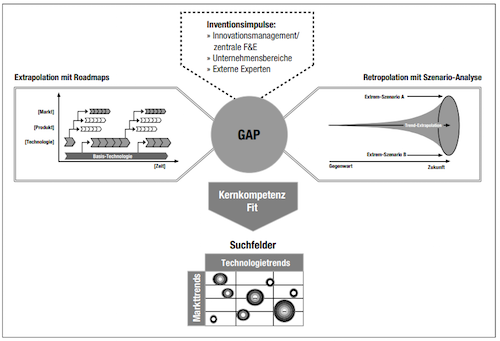What are search fields?
Innovation teams that work with search fields reduce misjudgements of technological progress and trends. Find out how you can use search field analysis to identify promising trends and develop fields of innovation.

The high error rate of innovations is often caused by misinterpretation of technological progress and predicted trends. This risk can be significantly reduced by clearly defining the search fields. In an overview, we will show you how, over time, you can recognize trends with the help of search field analysis and thus open up future-oriented fields of innovation.
Innovation search fields as a strategic instrument
For a target-oriented planning of innovations it is necessary to define a framework for the search for innovation ideas. The individual parts of the framework are called search fields:
- Innovation search fields represent future subject areas, where one wants to innovate and search for innovation potential, e.g. on the basis of markets, trends, product categories and technologies.
- Innovation search fields channel idea generation and ensure that all innovation activities conform to the corporate strategy and support it.
- Innovation search fields should be precise enough to allow a concrete orientation of the search for ideas. At the same time, however, they should also be defined broadly enough to encourage the search for innovative, creative solutions.
- Innovation search fields represent a bridge between strategic planning and generation of operational ideas.
How can search fields be identified?
The first starting points for defining innovation search fields will have resulted from the innovation strategy, which may have been developed, for example, on the basis of a SWOT analysis with corresponding strengths, weaknesses, opportunities and risks. Relevant search fields are formalized and analyzed by incorporating invention impulses from the corporate environment, and suitable instruments for defining promising fields of innovation.

Graphic: Concept of a search-field analysis, Oliver Gassmann & Christoph Kausch
The concept of a search field analysis, shown here, consists of three input elements from which search fields are derived in accordance with the company's core competencies and then systematized in a search field matrix:
- Inventive impulses: R&D employees, in particular, must be involved in the search field process. Furthermore, selected employees from other company divisions, and in some cases external specialists, Lead Users and technology suppliers, should be called in to develop search fields as part of the trend mapping.
- Roadmap: Roadmaps can be used to forecast how products, services or technologies will be presented at a specified future point in time (extrapolation principle). The roadmap is drawn up on the basis of environmental analyses as well as expert statements from R&D, marketing and external expertise.
- Scenario analysis: Using the scenario technique, possible consistent alternative scenarios can be derived from individual trends and unlinked individual events.
The combination of extrapolative and retropolative perspectives makes it possible to identify important future trends and gaps, and derive search fields from them, which are recorded in the search field matrix.
Search field matrix for identification of fields of innovation
The matrix is always made up of two factors that are particularly relevant for the search for innovation. These could be functions, fields of application, target groups, problem areas, market segments or, as in this example, market and technology trends. After the results of the scenario analysis and the road mapping process in the search field matrix, the next step is to identify those search fields that have the potential for sustainable and future-oriented innovations.
For this purpose, each individual search field of the matrix is worked through and evaluated with regard to its innovation potential. Fields with high potential are analyzed in more detail as possible fields of innovation. Evaluation criteria for the selection are:
- Consistency with corporate strategy and goals
- Growth potential
- Exploitable know-how potential
- Management competency with the new business area
- Positive and negative effects on existing business
- Cost of market entry
- Competitive situation and expected reactions from competitors
- Opportunities to acquire missing know-how
- Other opportunities and risks
The result of this selection process is a predefined number of search fields, which are listed in a priority list. Separate innovation workshops should then be held for each of the ultimately selected innovation search fields in order to find concrete ideas.
Conclusion: What are innovation search fields?
Strategically selected innovation search areas, which were determined by analyses and selection decisions, represent the core of the innovation strategy. They ensure that all innovation activities are in line with, and support, the corporate strategy. At the same time, innovation search fields channel the identification and selection of ideas by clearly defining areas within which ideas for innovations can be identified.











